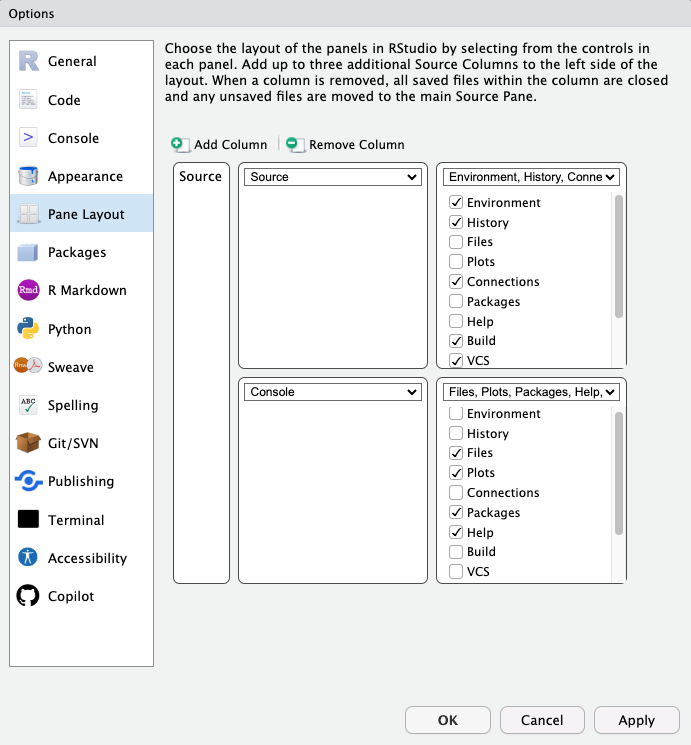Day 1: Introduction to R Statistical Analysis Software
Department of Applied Economics
University of Minnesota
Summer 2025
Outline
- Introduction
- Course Review
- Icebreaker
- Course Review
- Motivation
- What you can do with R?
- How do we use R in course in APEC?
- Basic knowledge about R and Rstudio
Course overview
This one-week course is a boot camp designed to introduce you to R statistical software. My goal is to build a strong foundation for your Ph.D.-level econometrics courses and future research.
By the end of this week, you will be able to:
to create and manipulate the base-R object data.
to do data manipulation with
data.tablepackage.to do data visualization with
ggplot2package.to conduct regression analysis with
lm()and make a publish-ready regression table withmodelsummary()package.to write Monte code for Carlo simulations using
for loopfunction.
We will meet each day from 1:00 PM to 4:00 PM, with office hours immediately following.
Each lecture is divided into three sessions, with each session consisting of a 50-minute lecture and a 10-minute break.
We will have in-class exercises at the end of each topic, and after-class exercises (optional) to practice!
No textbook is required. Below are recommended resources:
Recommended Reading
Essential Cheatsheets
About myself
- Qingyin Cai
- From China
- Fifth-year Ph.D. in Applied Economics
- Area of interests: Food and Agriculture Economics, Consumer Economics, and Environment Economics.
- Introduce yourself
- What’s your name?
- What’s your program?
- Where are you from?
- What brings you to UMN?
Motivation to learn R
What is R?
- R is a powerful programming language for a wide range of tasks:
- Data Manipulation: cleaning, reshaping, merging datasets, API.
- Various Analysis: descriptive analysis, regression, GIS, spatial analysis, machine learning.
- Data visualization.
- Data Manipulation: cleaning, reshaping, merging datasets, API.
- It’s a great tool to communicate your results with others (documentation, papers, slides, books, etc.).
Comparison of R, Stata, and Python
| Criteria | R | Stata | Python |
|---|---|---|---|
| Primary Use | Statistical analysis, visualization, research | Economics/social science research; valued for tested results | General-purpose; machine learning, web scraping, automation |
| Cost | Open-source | Commercial license | Open-source |
| Data Visualization | Excellent | Less flexible or aesthetically pleasing | Very powerful, but can be verbose |
| Ecosystem | Large academic community; many packages on CRAN | Strong in economics but smaller user base | Huge, diverse community |
| Handling Big Data | Base R is memory-bound; packages like data.table / arrow improve performance |
Memory-bound | Excellent |
AI and Learning R
- AI can help, but it cannot replace understanding.
- Tools like ChatGPT or Copilot can generate R code, but you need to know if the code is correct and appropriate.
- You’ll understand why a method works, not just how to run it.
- Tools like ChatGPT or Copilot can generate R code, but you need to know if the code is correct and appropriate.
- Academic integrity & skill development.
- Employers and researchers may expect you to adapt and debug code yourself.
- Long-term benefit.
- Once you know R, AI becomes a more powerful assistant — you can ask better questions and spot mistakes.
R in the APEC curriculum
- We use R extensively in the Econometrics series (APEC 8211-8214).
- To conduct regression analysis (OLS, IV, FE, etc.).
- To conduct Monte Carlo simulations.
- e.g., To understand the difference in variance inference techniques.
- e.g., To understand the difference in variance inference techniques.
- To conduct regression analysis (OLS, IV, FE, etc.).
- Don’t worry if you are new to this!
- Basic knowledge is enough to start.
- If you would like to learn R programming further, I recommend that you take Programming for Econometrics (APEC8221) and Big Data Methods in Economics (APEC8222).
- Basic knowledge is enough to start.
Rstudio
- What is it?
- Create New R code File
- Change the theme (Optional)
- Multiple panes (Optional)
- Command Palette (Optional)
You can use app to write and run R codes, but it has a terrible graphic user interface.
Rstudio is an Integrated Development Environment. It provides a user-friendly interface to write and run R code, view plots, and manage files.
You must install R (the engine) before you can use RStudio!
R studio looks like this:
To create new R script file, click the
+button on the top-left corner of the Rstudio, or hitCtrl+Shift+N(Cmd+Shift+Non mac).To save the file, click the floppy disk icon , or
Ctrl+S(Cmd+Son macOS).
- You can change the appearance of Rstudio by going to
Tools->Global Options->Appearance->Editor themeand select your favorite theme.
- You can have multiple code panes in Rstudio.
- To create a new pane, go to
Tools->Global Options->Pane Layout->Add Column.
- In the same window, you can also change the layout of the panes.

Recent R-studio has a new feature called “Command Palette.”
Hit
Ctrl+Shift+P(Cmd+Shift+Pon macOS) on your keyboard, or go toTools->Show Command Palette.From here, you can search for and do almost anything: create new files, open projects, etc.
Rstudio: Running Code
Let’s write some codes.
R code
- Any thing you write in the source (or console) pane is regarded as R code.
- To run (execute) the code, select the code line, and click the “Run” bottom, or use the shortcut key:
Ctrl+Enter(Cmd+Enteron macOS).
Comment block
- Any line starting with a
#is a comment. R will ignore it. Use comments to leave notes for yourself and others!
Summary
You are now familiar with the basics of RStudio. As long as you know how to create, save, and run a script, you are ready for the next lecture.
For more details, see the official RStudio IDE Cheatsheet.
While RStudio is the most popular tool, you can also run R in other editors like Visual Studio Code to run R. Nevertheless, Rstudio is a great starting point to get familiar with R.



